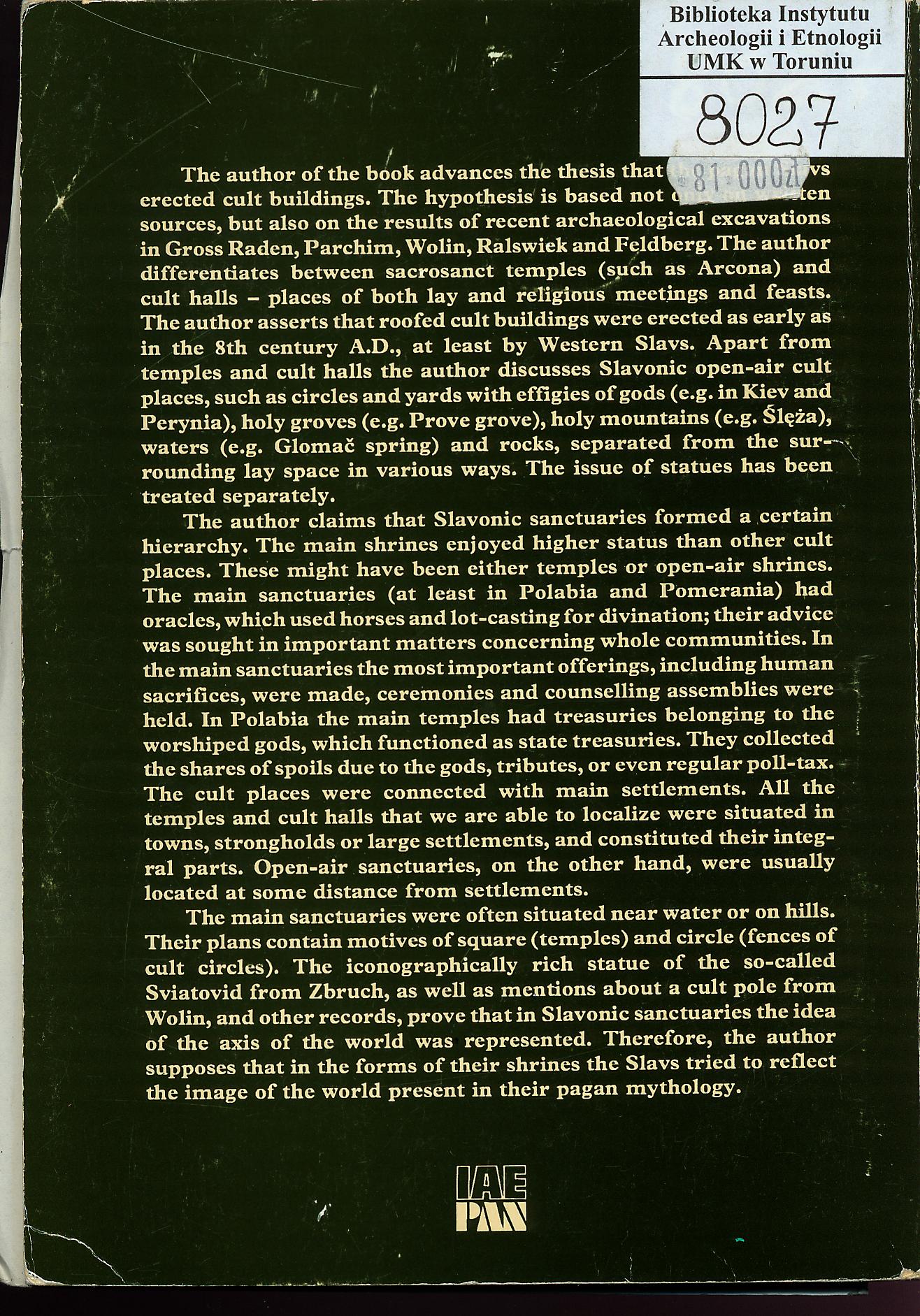image001 (71)

Biblioteka Instytutu Archeologii i Etnologii UMK w Toruniu
802?
The author of the book advances the thesis that erected cult buildings. The hypothesis is based not sources, but also on the results of recent archaeological excavations in Gross Raden, Parchim, Wolin, Ralswiek and Fęldberg. The author differentiates between sacrosanct temples (such as Arcona) and cult halls - places of both lay and religious meetings and feasts. The author asserts that roofed cult buildings were erected as early as in the 8th century A.D., at least by Western Slavs. Apart from temples and cult halls the author discusses Slavonic open-air cult places, such as circles and yards with effigies of gods (e.g. in Kiev and Perynia), holy groves (e.g. Prove grove), holy mountains (e.g. Ślęża), waters (e.g. Glomać spring) and rocks, separated from the sur— rounding lay space in various ways. The issue of statues has been treated separately.
The author claims that Slavonic sanctuaries formed a certain hierarchy. The main shrines enjoyed higher status than other cult places. These might have been either temples or open-air shrines. The main sanctuaries (at least in Polabia and Pomerania) had oracles, which used horses and lot-casting for divination; their advice was sought in important matters concerning whole communities. In the main sanctuaries the most important offerings, including human sacrifices, were madę, ceremonies and counselling assemblies were held. In Polabia the main temples had treasuries belonging to the worshiped gods, which functioned as State treasuries. They collected the shares of spoils due to the gods, tributes, or even regular poll-tax. The cult places were connected with main settlements. Ali the temples and cult halls that we are able to localize were situated in towns, strongholds or large settlements, and constituted their integ-ral parts. Open-air sanctuaries, on the other hand, were usually located at some distance from settlements.
The main sanctuaries were often situated near water or on hills. Their plans contain motives of square (temples) and circle (fences of cult circles). The iconographically rich statuę of the so-called Sviatovid from Zbruch, as well as mentions about a cult pole from Wolin, and other records, prove that in Slavonic sanctuaries the idea of the axis of the world was represented. Therefore, the author supposes that in the forms of their shrines the Slavs tried to reflect the image of the world present in their pagan mythology.
im
VXX
Wyszukiwarka
Podobne podstrony:
image001 (71) Biblioteka Instytutu Archeologii i Etnologii UMK w Toruniu 802? The author of the
image001 (71) Biblioteka Instytutu Archeologii i Etnologii UMK w Toruniu 802? The author of the
Etnologia polska. Między etnografią a antropologią kulturową 71 mach Instytutu Archeologii i Etnolog
UNIWERSYTET GDAŃSKI—WYDZIAŁ HISTORYCZNY Wydział Historyczny INSTYTUT ARCHEOLOGII I ETNOLOGII ul.
Instytut Archeologii i Etnologii, pokój nr 44ul. Bielańska 5, Gdańsk
Instytut Archeologu i Etnologii Polskiej Akademii Nauk Instytut Archeologii Uniwersytetu Mikołaja Ko
56 (268) * MUZEUM ARCHEOLOGICZNE W GDAŃSKU
CZERSKWZGÓRZE ZAMKOWEBADANIA W LATACH 1974-1983 INSTYTUT ARCHEOLOGII I ETNOLOGII POLSKIEJ AKADEMII N
Ośrodek Badań nad Kulturą Późnego Antyku i Wczesnego Średniowiecza Instytutu Archeologii i Etnologii
więcej podobnych podstron